This is a long read summarising my findings from five years studying mountain hares in the Peak District in the context of our changing climate.
It’s a sobering thought that our changing climate is already impacting our mountain hares: super furry, white animals that are only found in the high hills of the Peaks and Scotland. One of the few creatures in the UK to don a white coat for winter (alongside ptarmigans and stoats), the continued drop in snowfall each year means there could soon be a mismatch with hares no longer being camouflaged and protected from predators. COP26 has given us a chance to reflect on how we’re heating up and destroying our planet. The United Nations warns that a growing global population combined with the unsustainable use of natural resources is having a devastating impact on our planet – propelling climate change, destroying nature and raising pollution levels.
The effect on our climate is now apparent to everyone. In Britain we’re enjoying warmer summers and milder winters. But the effects of climate change are felt most keenly at the polar regions, where Arctic sea ice is melting at an alarming rate. Polar sea ice plays a critical role, reflecting heat from the sun back into space, helping maintain global temperatures. As the ice melts, climate patterns change, with warmer air temperatures moving the jet stream and oceanic air currents, causing severe weather events. The ice melt also causes sea levels to rise, which has catastrophic impacts for people and wildlife living in coastal areas.
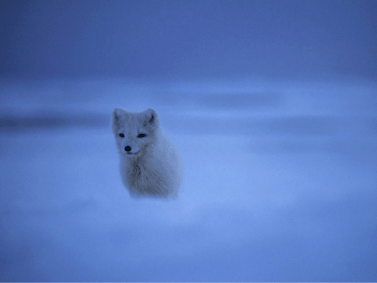
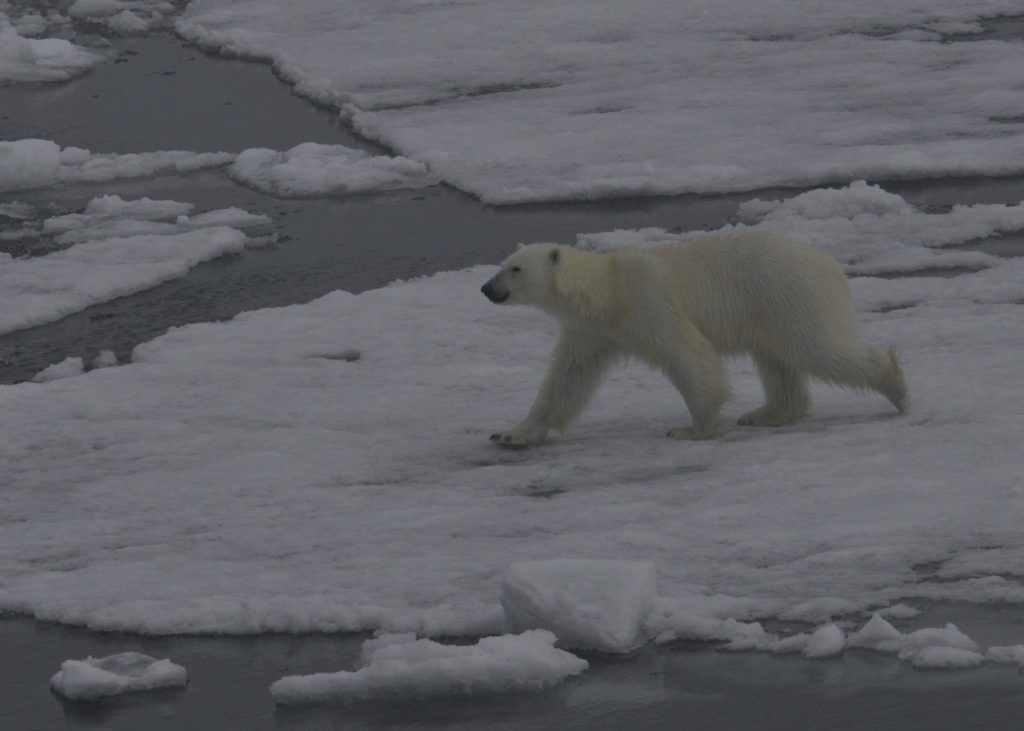
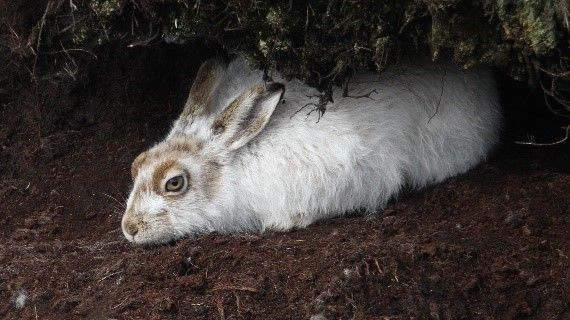
We now know that, as the IPCC states, unless there are immediate, rapid and large-scale reductions in greenhouse gas emissions, limiting warming to close to 1.5°C or even 2°C will be beyond reach. Many of the changes observed in the climate are unprecedented in thousands, if not hundreds of thousands of years, and some of the changes already set in motion—such as continued sea level rise—are irreversible over hundreds to thousands of years.
The World Wildlife Fund explains that a 1.5°C average rise may put 20-30% of species at risk of extinction. If the planet warms by more than 2°C, most ecosystems will struggle. Many species around the globe are very specialised and superbly adapted to their ecosystems. When climatic impacts upset balances in local ecosystems, numerous habitats will alter or experience sudden changes. Many animals and plants cannot cope with these changes. As areas experience extreme heat, aridity, or floods, species will struggle to cope. One of these species is our mountain hares.
Super furry white animals
Animals adapted to cold climates are especially vulnerable to effects of increasing temperatures in the northern and polar regions, particularly because any changes may impact how easily they can find food. Obvious examples are some of our most iconic animals which all wear furry white coats.
Polar bears suffer as ice melts and they’re unable to prey on seals sitting on the ice. Across the Arctic four of the 19 known groups of polar bears are decreasing. Arctic foxes, now extinct in Finland, are listed as endangered in Sweden and Norway. They’re suffering from fewer lemming prey. As snow thaw-freeze cycles increase during warmer winters, lemmings can’t forage and starve. Arctic foxes from the southern parts of their Scandinavian range are moving north to coastal areas, where food sources are more reliable. Mountain hares are Ice Age relicts – a cold-adapted species that was ‘left behind’ in Britain when the ice retreated. Now the number one threat facing our mountain hares is climate change. At the Swiss Institute for Forest, Snow and Landscape Research, the talented ecologist Maik Rehnus explains that mountain hares are the indicator species for Arctic-Alpine ecosystems… they react very sensitively to environmental changes.
Five climate change processes affecting mountain hares
Mountain hares prefer a climate envelope of cold and snow
Mountain hares evolved over the last 2 to 4 million years, as cold adapted species. They emerged after the Pleistocene, the last Ice Age, and followed the movement and eventual retreat of glaciers.
They’ve been able to do this because they benefit from winter-adapted physiology: excellent insulating thick white coats, which allow them to thrive in temperatures as low as minus 30 degrees. Even when the winter air temperature drops this low, mountain hares can survive, keeping their body temperature stable. Thus the mountain hare has a natural climate envelope: an upper and lower temperature and precipitation preference. Mountain hares need weather that’s cold and at least sufficiently freezing that precipitation falls as snow. Which is not to say mountain hares don’t occasionally enjoy a good sunbathe, but generally their preference is for a cold snowy environment.
Forecasts are for warming temperatures. Consequently, mountain hares are likely to shift their ranges and head northwards or to higher colder elevations, whilst their lowland cousins, European brown hares, are predicted to expand their range all over. It’s possible, probable that populations in places such as Germany will disappear altogether. In Switzerland, mountain hares – which have already been spotted moving higher – are likely to climb so far up the Swiss mountains into little sky-island ecosystems that individual populations becoming fragmented.
My recent investigations for the Peak District show that mountain hares will move to higher levels. As average winter temperatures rise from historic levels of minus 2 degrees to plus 2 degrees by 2050, precipitation will fall as rain not snow. And although winters are forecast to be wetter, overall annual precipitation will decrease by 25%. If our mountain hares follow their natural climate envelope preferences, they’ll move to the very hill tops, above 570m, meaning that the amount of available habitat will shrink from 168km2 to just ~20km2. Mountain hares will only remain in Kinder Scout, parts of Bleaklow and a small area near Rishworth, whilst those living in Derwent Edges and Margery Hill will vanish.
Increasing competition with brown hares
Brown hares are what’s known as a sister species. They’re physiologically similar, yet not the same as mountain hares. Originally from central Asia, brown hares are steppe herbivores which weren’t in Europe during the Ice Ages, they arrived afterwards. They’re suited to warmer, drier climates, foraging on grasses. Introduced to Britain by humans as early as the Neolithic period but definitely by the Romans, they compete with mountain hares for food where they co-exist. In Ireland and Sweden, huge areas of mountain hare range have been ceded to brown hares.
However, this interspecies competition might presently happen rather less in mainland Britain. Why? British mountain hare feed almost exclusively on heather over winter and it makes up a high proportion of their summer diet too. But brown hares can’t digest heather very easily. This was proved during some interesting feeding experiments carried out during the 1990s. Mountain and brown hares were kept in cages and fed pellets sprayed with resin, similar to woody heather. Brown hares suffered sodium loss, becoming dehydrated and slightly unwell; mountain hares coped fine. There is something in mountain hare digestive detoxification chemistry which allows them to be more of a dietary generalist.
Consequently, here in Britain, mountain hares occupy upland bogs and heather moorland and feed mainly on heather, whereas brown hares occupy agricultural and arable fields where they feed on grass. But worryingly, based on temperature and precipitation studies, brown hares are forecast to greatly increase their range as hills become warmer and drier. In the Peak District, brown hares will move up the hills, following the mountain hares and, ultimately, squeezing them out.
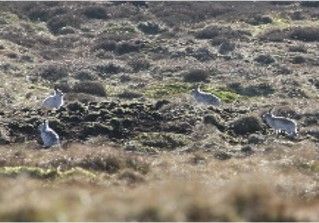
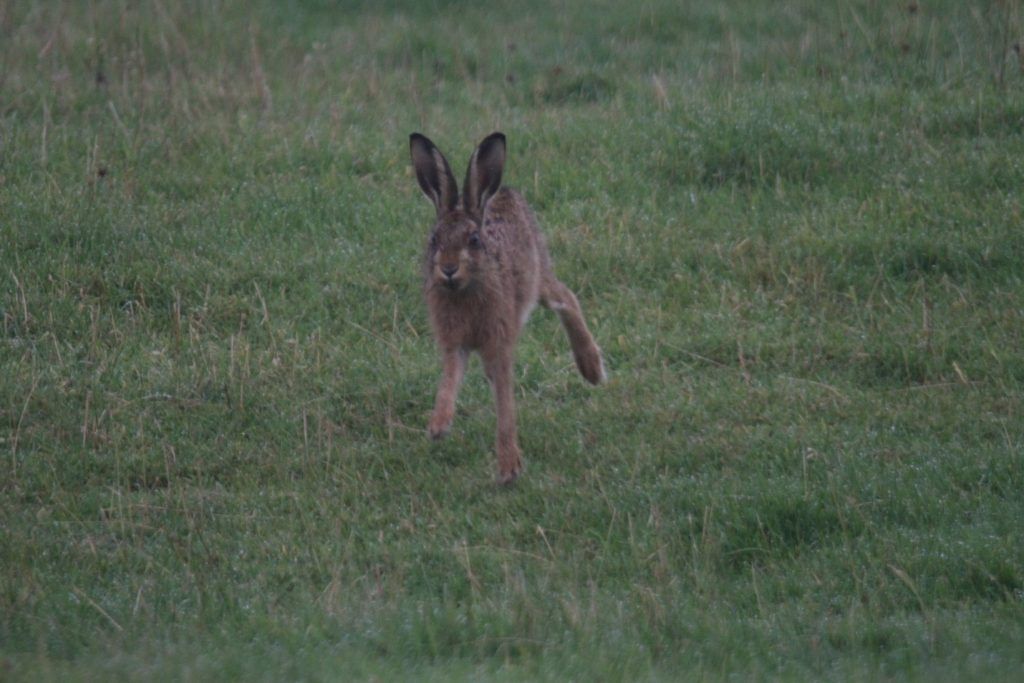
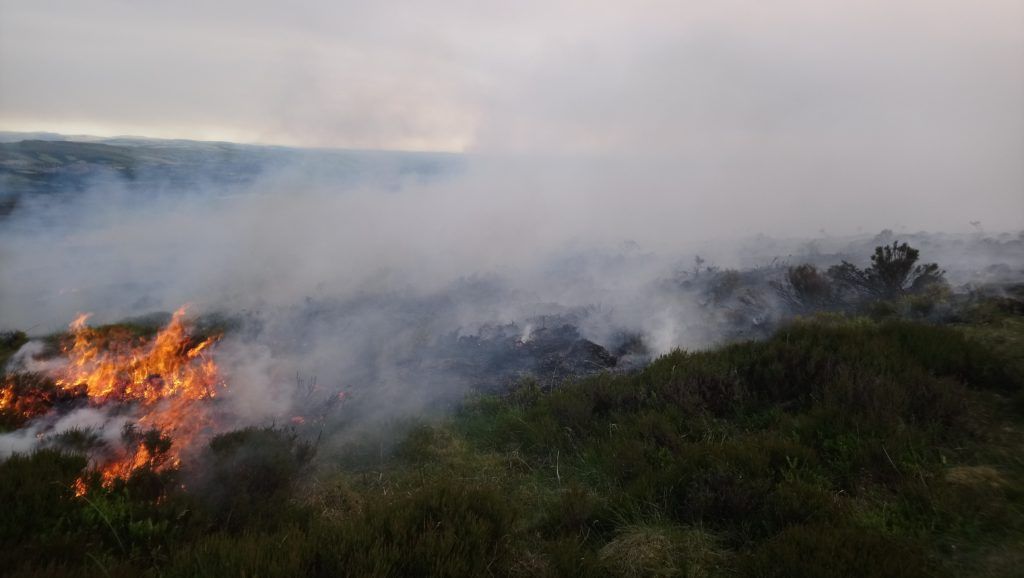
Changes to food availability and water
Heather is key for the long-term survival of mountain hares in England. Without heather, it’s likely brown hares will outcompete our mountain hares and they’ll die out. We can’t predict what the Peak District upland will be by 2050. Presently Bleaklow, Kinder Scout, Derwent Edges and Holme Moss are all dominated by substantial amounts of wet blanket bog, including some heather. Typically, when these dry out they give way to more extensive upland heather communities, which might be good for mountain hares. However, if soils dry out too much then grasses might take over. This happened over large areas of heather moorland which was superseded by acid grassland in the 1980s, although that was particularly exacerbated by excessive sheep grazing.
Meanwhile if moors are drier, which happened in 2018, less standing water, such as in ponds, is available and vegetation lacks moisture, turning dry. These situations make it hard for dehydrated female hares to provide milk, when raising leverets.
In the Peak District, moorland restoration is underway by Moors for the Future Partnership, RSPB Dove Stone and the National Trust. These organisations were tasked with protecting upland peat layers which are important for carbon storage. Their investments in blocking gullies, raising the water table and revegetating the landscape, have yielded a verdant, vibrant bog ecosystem with a wide variety of plants, shrubs and mosses. These areas are now home to substantial numbers of mountain hares which appear to be thriving in these restored areas. It appears bog restoration goes a little way towards trapping carbon and reducing climate change; and a long way towards providing a beneficial ecosystem for wildlife.
Wildfires
Wildfires are more commonly associated with Australia and Brazil. However, most years have seen consistent increases in wildfires in the Peak District. Researchers investigating the frequency of fires in the Peaks have cautioned that, depending on the actual amount of greenhouse gas emissions worldwide, long, dry summers may become the norm rather than (as at present) the exception. Recreational users of Peak District moorland might welcome such weather, but the moors themselves are likely to suffer and, unless substantial extra resources are put into fire prevention and firefighting, the cost to ecosystem services of climate change in this upland region is likely to be high.
Like many animals, mountain hares don’t know how to escape fires. I witnessed this first hand during the Saddleworth fire in 2018, as I was retrieving camera traps which were inadvertently caught up in the fire zone. I saw mountain hares lying close by, dormant, unsure how to escape the flames, only too reminiscent of images from Australia of koala bears being burned in wildfires.
Coat colour camouflage mismatch
This is a subtle yet ironic consequence of climate change. Mountain hares evolved over thousands of years so that their brown summer fur moults to a white sleek coat. This is a biological process triggered by changes in autumn. As day(light) shortens and air temperatures change, the hares grow coats of thicker white fur with hollow insulating hairs. Being white, this coats should provide mountain hares with excellent camouflage from predators against the snow. Now there’s less snow, mountain hares are glaringly obvious against a brown background. Recent studies have shown that mountain hares may be colour-mismatched by up to 35 days every year, compared with 60 years ago when we had more snow. This makes mountain hares vulnerable to being seen by predators such as foxes, stoats, raptors, and owls. Whilst substantial predator control on English uplands reduces these risks, nonetheless some predation does happen. There’s good news too though. A recent study showed that the warm winter coat, despite being the wrong colour, still provides survival benefits that outweigh the costs.
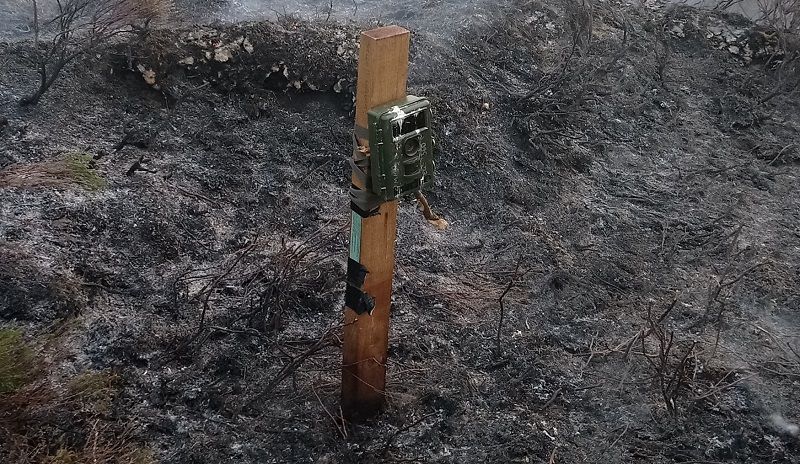
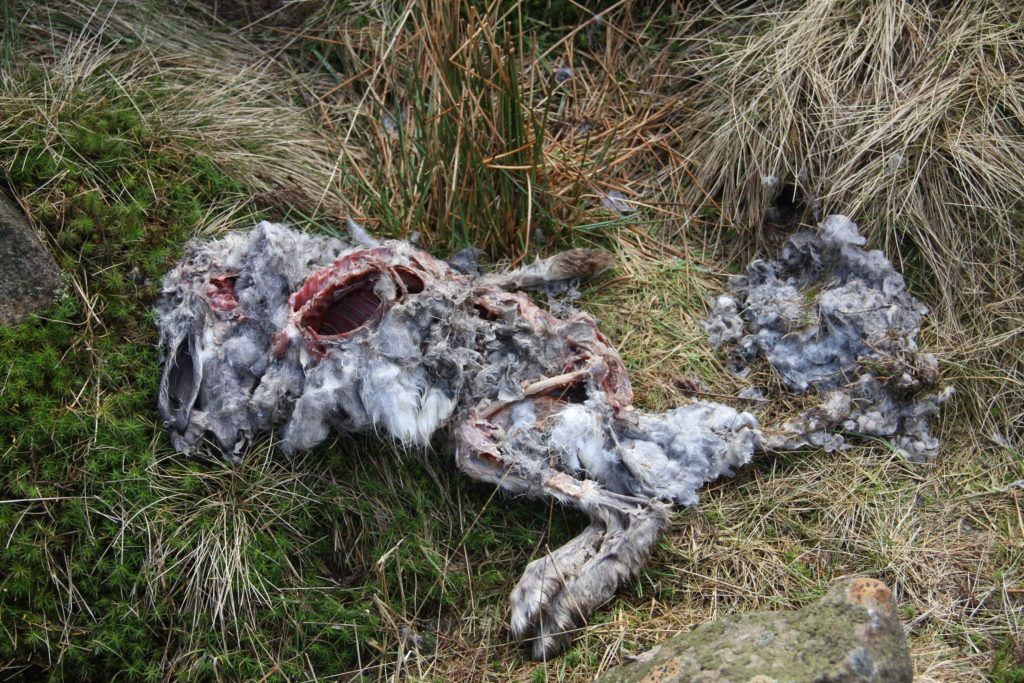
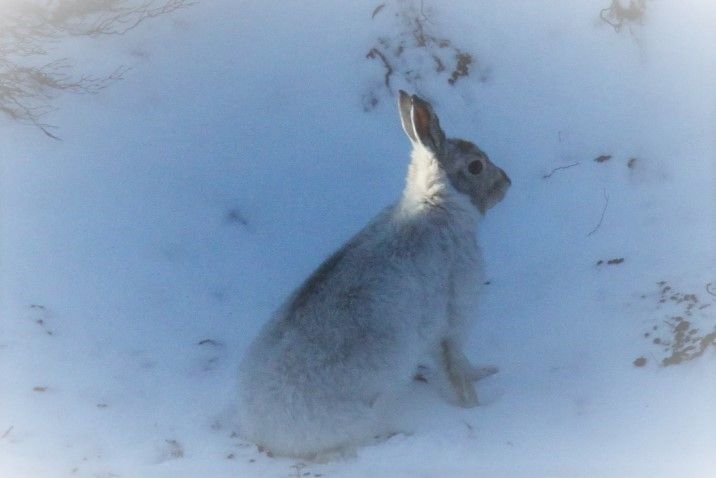
Cooling reflections
It’s sobering to reflect how extensively our actions, which are creating significant changes to our climate, are impacting the other species that rely on our planet too. As we heat up our planet, we’ve created five processes which are adversely affecting our furry white friends, including mountain hares. In truth, we don’t know what their extent or frequency will be but we do know that they’re occurring. Already. It may be too late to prevent some of the consequences but there are things we can do:
- We can care for a restore habitats like blanket bog which provide critical refuge for hares
- We can continue to monitor our wildlife populations so we know how they’re doing and can act before it’s too late
- And we can use global initiatives, such as COP26 to understand how we can change our own behaviour in order to help.
It’s up to each of us to act as leaders of our own society, reducing our own individual carbon emissions and helping furry white animals to survive.
Written by Carlos Bedson.
You can find out more about Carlos and his work at his website.
Thank you to all our donors who helped us fund this work. You can help us support more projects like this with a donation today:
